Tennessee is known for many things in North America: whiskey, country music, Nashville chicken sandwiches, banana pudding, and vast rolling hills, to name a few. But hummingbirds? You might be surprised.
The number of western hummingbirds spending winters in Tennessee is on the rise.
Once upon a time, before the ’90s, bird watchers had only ever reported seeing a single Rufous hummingbird. Then, between 2007 and 2008, that number had increased to over 100! There are a variety of factors that could have contributed to this, but climate change and a surge in hummingbird gardening might be among the most likely.
In fact, there are now several western hummingbirds found in Tennessee during the winter and non-breeding season, and records of the return of these banded birds.
All of the Hummingbirds You Can See in Tennessee
There are nine seasonal hummingbird species in Tennessee, with the year-round residents being the Rufous hummingbird and Ruby-throated hummingbird.
Additionally, rare vagrants have been spotted in all counties of Tennessee during the spring and summer. All kinds of hummingbirds are known to visit the occasional backyard hummingbird flower garden, especially if equipped with a hummingbird feeder, tubular flowers in different colors, running water, and misters.
Allen’s Hummingbird

- Scientific Name: Selasphorus sasin
- Length: 3 – 3.5 in
- Weight: 0.1 oz
- Wingspan: 4.2 in
Description:
Allen’s hummingbird looks rather similar to the Rufous hummingbird. Each has copper-colored feathers, but the biggest distinction between these two types of hummingbirds is the Allen’s hummingbird’s green back and crown, with hints of a rusty, rufous coloring on its flank, rump, and coppery orange tail. It also has a red-orange gorget, or throat feathers.
The female Allen’s hummingbird is golden and green, with paler shades on her flanks and throat, and her throat has rusty dots with a tiny patch of red-orange in the center.
Additional Information:
The Allen’s hummingbird is an occasional visitor to Tennessee gardens, typically preferring to reside along the Californian and Oregon coastal stretch.
One division of Allen’s Hummingbird, Selasphorus sasin sedentarius, is non-migratory and resides permanently on the Channel Islands off the coast of California.
Like all hummingbirds, they are attracted to bright red and orange tubular flowers in addition to being reliable pollinators. They will also come to sugary nectar feeders.
Anna’s Hummingbird

- Scientific Name: Calypte anna
- Length: 3.9 – 4.3 in
- Weight: 0.1 – 0.2 oz
- Wingspan: 4.7 in
Description:
The male Anna’s hummingbird has a brilliant roseate pink coloring on its throat and crown, appearing purple or black in lower light. Its underside is greyish, and its back is glittering green.
Females have a pale-gray chest and underbelly, with red dots on their speckled throats. Their white-tipped tail feathers are tawny and have varying shades of black to green in the center.
Additional Information:
The male Anna’s is a famous hummingbird for producing a sound that is intricate, scratchy, and strident.
Like other usual hummingbirds, Anna’s can fly backward and upside-down. The design of their wings is a unique ball socket at the shoulder that permits 180-degree rotation in all directions allowing for beautiful flight displays.
Black-chinned Hummingbird

- Scientific Name:Archilochus alexandri
- Length:.3.5 in
- Weight: 0.1 – 0.2 oz
- Wingspan: 4.3 – 5 in
Description:
The male black-chinned hummingbird gets its name from its black throat adorned with a dazzling purple throat band (when exposed to light). It has a gray-white underside, and a dark tail forked at the end with shades of dark green and black.
Females and immature males are pale on their undersides, with a very slightly mottled throat. The female also has green-gold coloring across her back and crown.
Additional Information:
The black-chinned hummingbird is an occasional vagrant to Tennessee. They reside across the western United States, reaching far north, into Canada, east into New Jersey, and even down to southern Mexico.
This territorial hummingbird prefers a solitary mating ground and will defend its territory from a variety of birds and other creatures.
The male woos the female in elaborate oval flights and u-shaped dives from 60 to 100 feet in the air, generating a series of noises as air rapidly passes through their wings.
Broad-billed Hummingbird
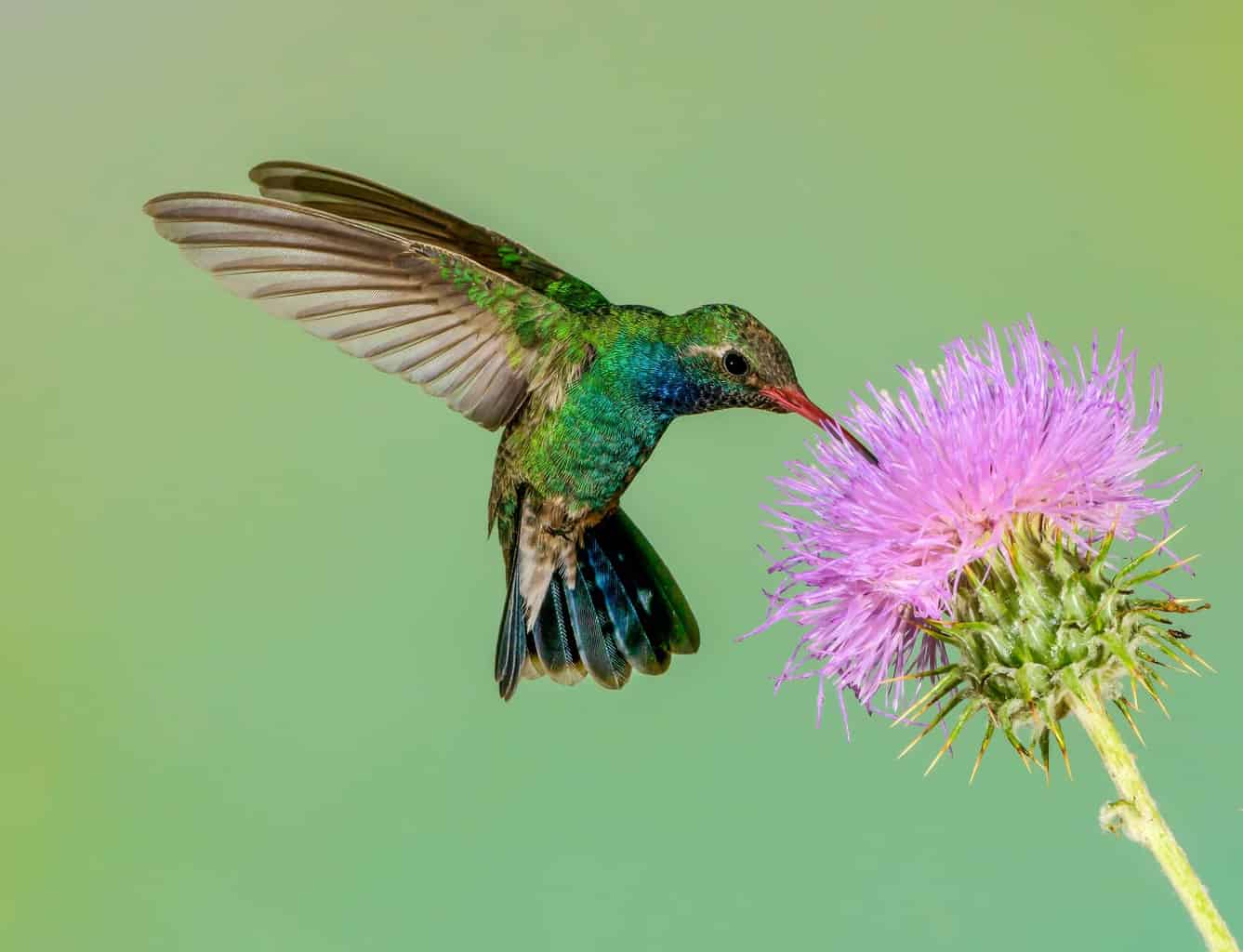
- Scientific Name:Cynanthus latriostris
- Length: 3.1 — 3.9 in
- Weight: 0.10 – 0.14 in
- Wingspan: 5.1 in
Description:
The male broad-bill has a brilliant red bill, a shimmering, sapphire-blue throat and chest, and a golden-green body.
The female is golden-green on her back and crown, and pale underneath with a white stripe around each eye. Her tail is white-tipped.
Additional Information:
The broad-billed hummingbird’s habitat range is commonly found in South Mexico, though they do make their way to the lush gardens and mountainous canyons of the southwestern United States.
Generally, the broad-bill establishes summer breeding grounds in Arizona at approximately 3,000 to 5,000 feet, in wooded riparian areas and thorn forests.
They use their extendable tongue to feed on nectar from flowers, regularly consuming 1.6 to 1.7 times their body mass in a day.
When courting a female, the male hovers a few feet above ground level, not far from the female, then performs a pendulum flight, swinging in an arc back and forth.
Broad-Tailed Hummingbird
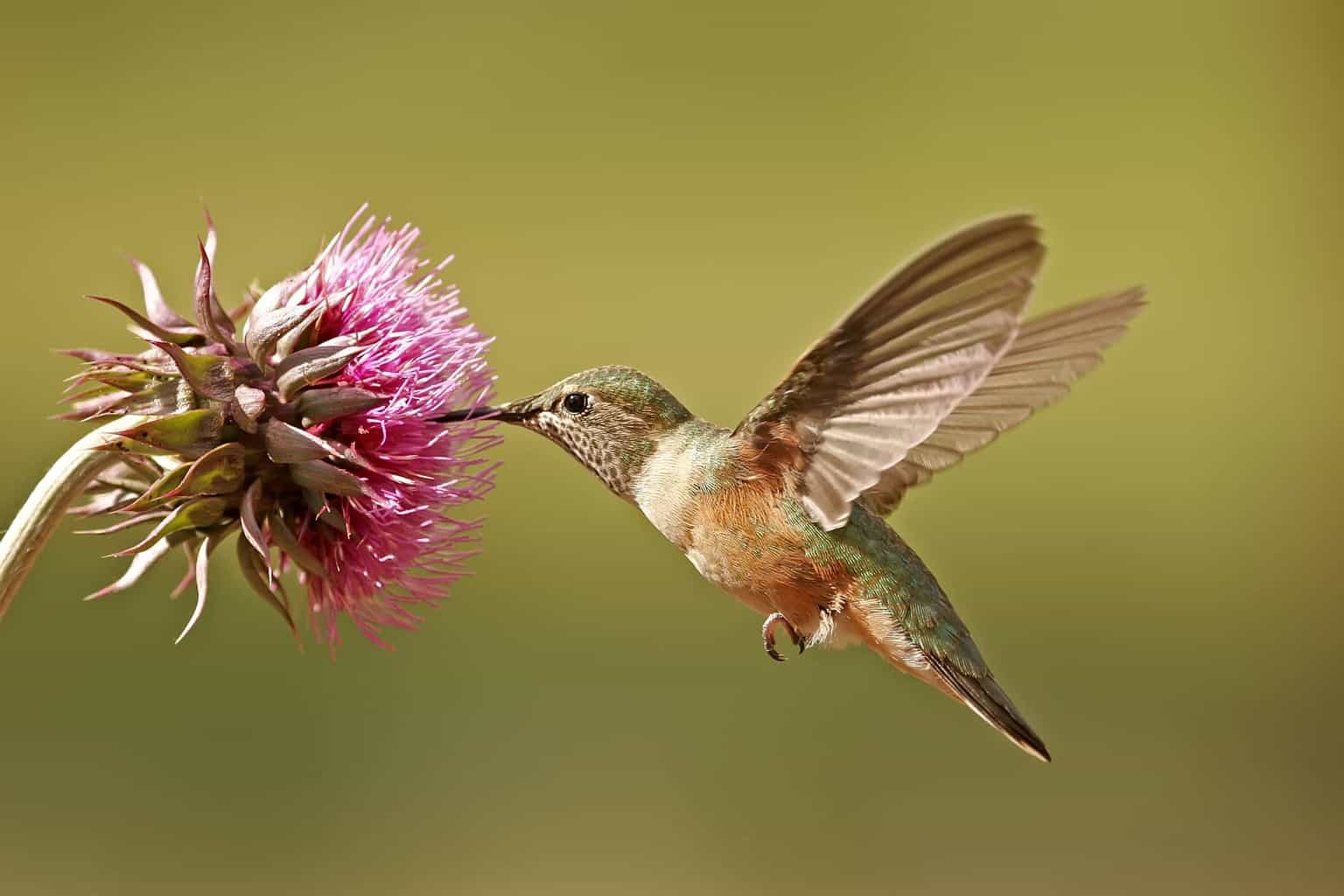
- Scientific Name: Selasphorus platycercus
- Length: 4 in
- Weight: 0.13 oz
- Wingspan: 5.25 in
Description:
The adults of both sexes have luminescent green plumage across their back, copper-brown flanks, a white eye-ring around each eye, and an off-white chest.
They also have a white-tipped round tail, with a jet-black subterminal band that extends past their wingtips (this feature inspired their name).
This hummingbird species is sexually dimorphic. The males have a brilliant red-pink gorget, and the females’ coloring is in softer shades, with auburn flanks and colored dots on their cheeks, neck, and chest.
Additional Information:
These beautiful birds reside in the underbrush of Oak or Pine woodland or open grasslands, trees, and shrubs.
The male produces an insect-like trilling sound in dive displays while attempting to attract females, which sounds similar to the noise produced by a cricket.
Calliope Hummingbirds
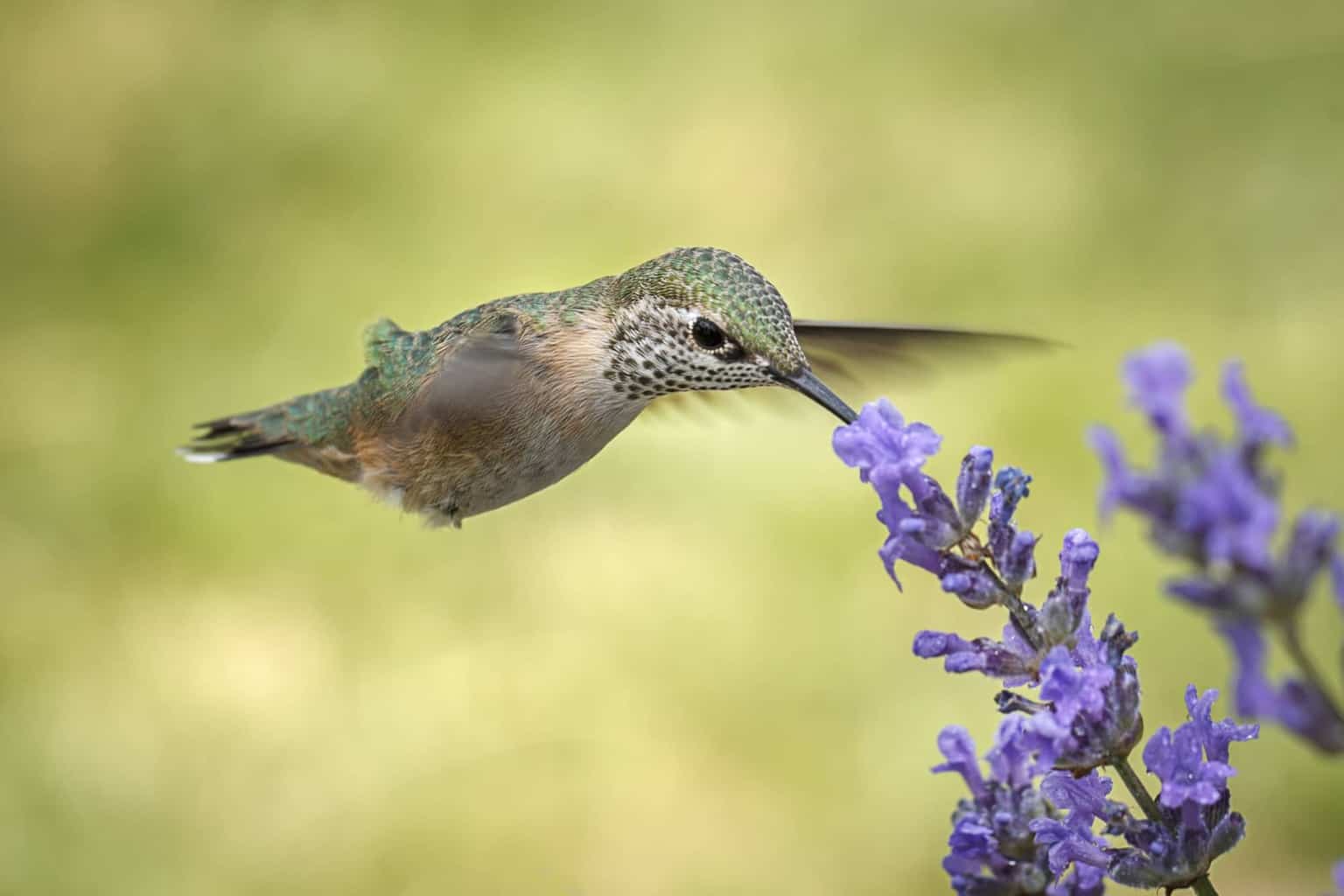
- Scientific Name:Selasphorus calliope
- Length: 2.8 – 3.9 in
- Weight: 0.071 – 0.106 oz
- Wingspan: 4.3 in
Description:
The calliope is the smallest American hummingbird species — in fact, it’s the smallest breeding bird in the United States. The Bee hummingbird, found in Cuba, is the smallest bird worldwide.
Male calliopes have bright streaks of magenta lining their throats, a white underside, and scintillating green feathers on their backs.
Female calliopes lack the extraordinary crimson-fuchsia streaks of the male. Instead, she has a gray-white throat, chest, underpants, and a metallic green color on her back and crown.
Additional Information:
This compact bird is a rare, accidental visitor to Tennessee, and its established breeding ground is diverse, existing in all types of habitats. Calliopes will build cushioned nests in the high, frosty Rocky Mountains or in meadows at lower altitudes.
Each year, the calliope also undergoes a massive feat, flying 5,000 miles in a single flight as winter approaches and it seeks out its wintering grounds.
A particular delight among bird lovers is watching these hummingbirds fall asleep, as they enter a hibernation-like condition to conserve energy, called torpor. This lowers their metabolism, respiration, and heart rate while they hang upside-down.
Mexican Violetear
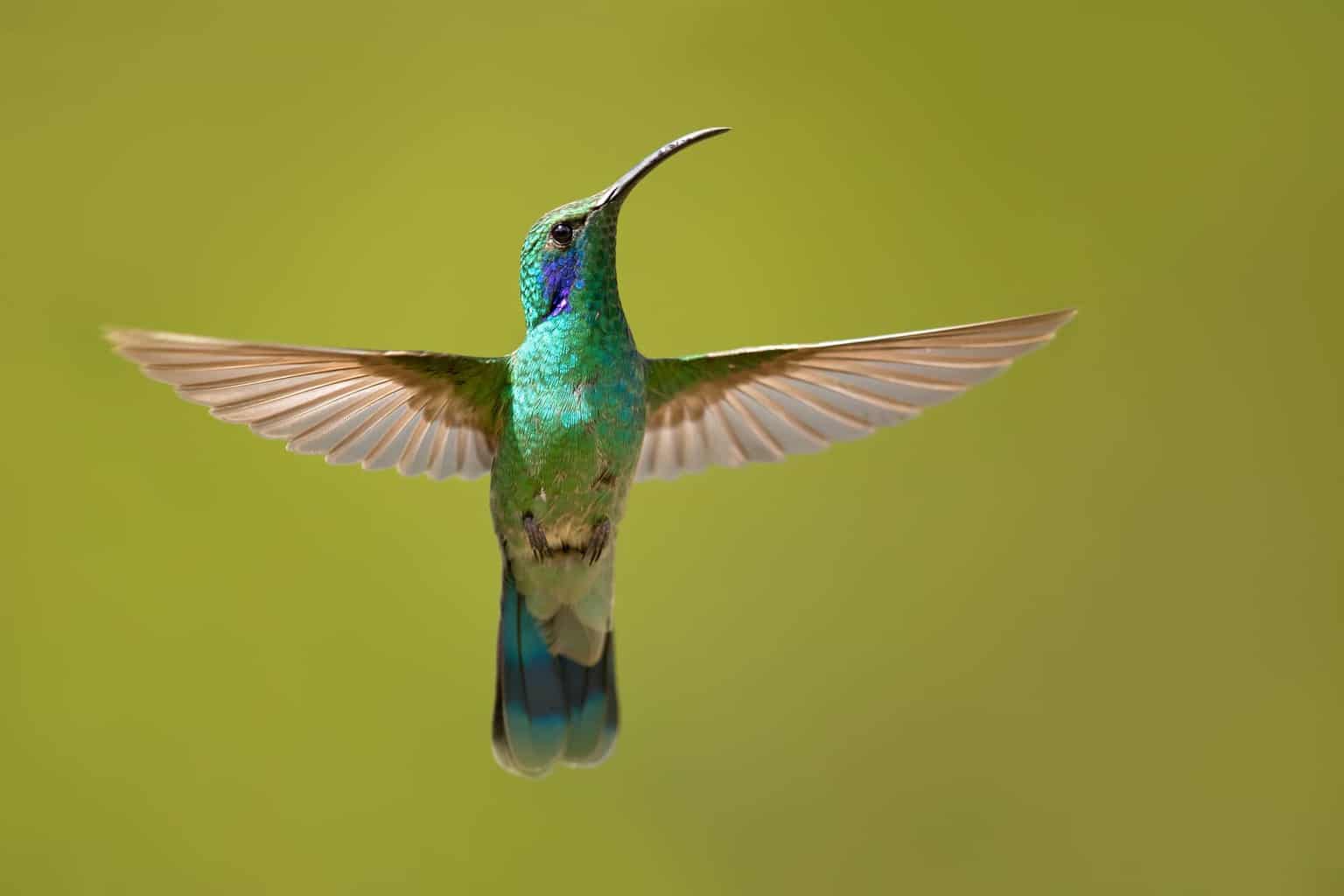
- Scientific Name:Colibri thalassinus
- Length: 3.8 – 4.7 in
- Weight: 0.17 – 0.20 oz
- Wingspan: 7 in
Description:
The Mexican Violetear is a relatively large hummingbird in terms of wingspan, mostly.
Its plumage is glistening sapphire and emerald-green throughout its entire body, and its tail has bronze feathers in its center with a jet black subterminal band.
Additional Information:
The Mexican Violetear is primarily solitary and searches for nectar from plants alone. However, they do gather around certain plants like the inga.
Generally, Mexican Violetear’s habitat is among the canopies of trees in subtropical and low temperatures. They also enjoy the edges of wooded areas and forests.
Ruby-throated Hummingbird
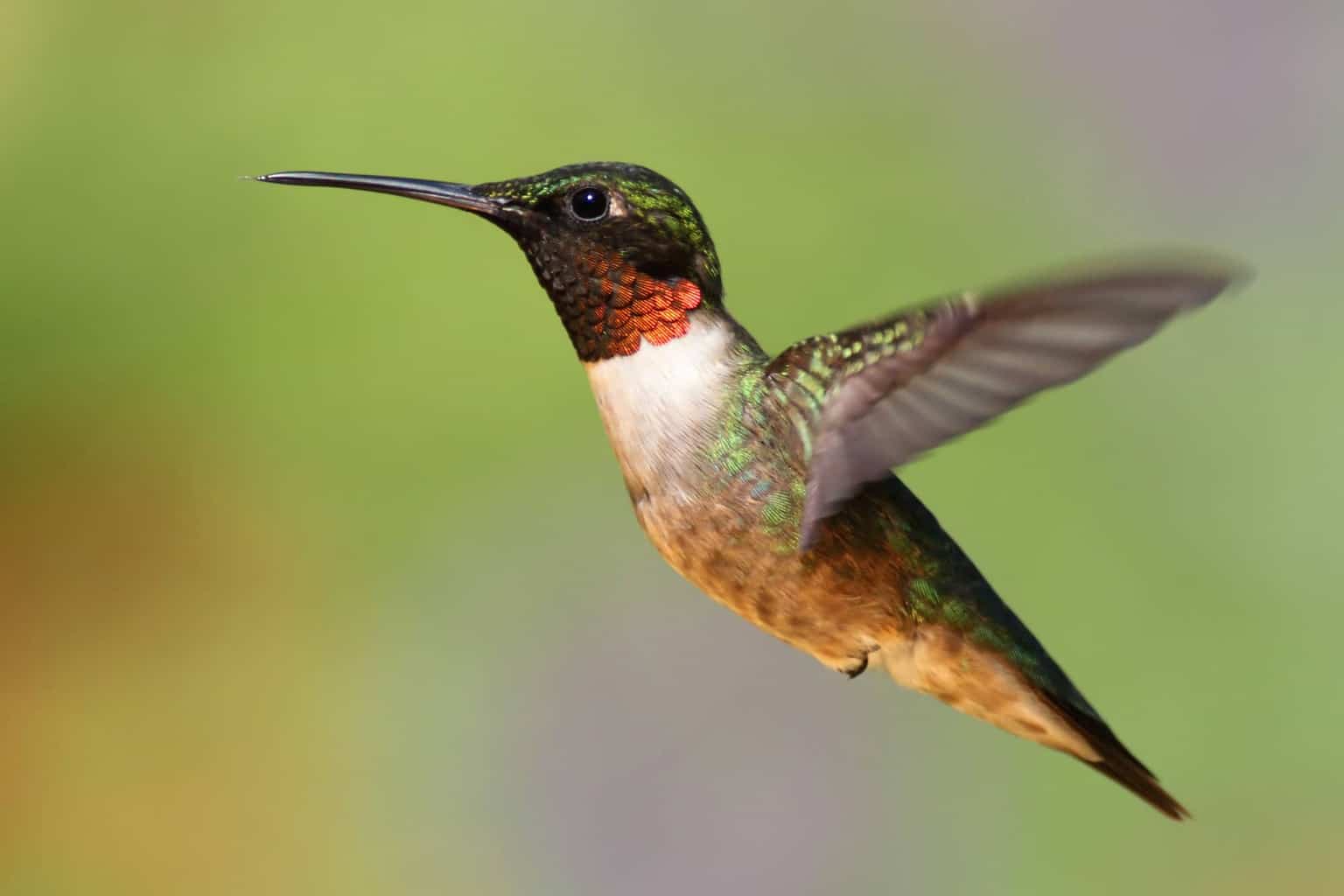
- Scientific Name: Archilochus colubris
- Length: 2.8 – 3.5 in
- Weight: 0.071 – 0.212 oz- (females) 0.13 oz (males) 0.12 oz
- Wingspan: 3.1 – 4.3 in
Description:
The ruby-throated male sports a brilliant ruby-red throat (hence the name) and a white-collar band. Covering its back and crown are shades of gold and emerald green. Its underside is gray, and it has a forked tail.
The females don’t have the distinct ruby-red throats of the males. They have an emerald, golden-green coating on their backs and crowns.
Additional Information:
The Ruby-throated hummingbird breeds in and is the only native resident of Tennessee. However, many hummingbird species stop in Tennessee on their way to northern breeding grounds in Canada and the northern US.
The male hummingbird is the first to appear in March/April and leave around October. The females and young follow two weeks later.
Every year this medium-sized hummingbird migrates incredible distances — 1,200 miles ceaselessly from Central America to the far northern reaches of Canada, and 530 miles of that over the Gulf Coast!
Attracting migrating Ruby-throats is fairly simple, so long as you establish your hummingbird garden and supply it with a reliable nectar source, whether that’s from tubular flowers or homemade nectar. They will also appreciate bird feeders, misters, and sources of running water.
Rufous Hummingbird

- Scientific Name:Selasphorus rufus
- Length: 2.8 – 3.5 in
- Weight: 0.071 – 0.176 oz
- Wingspan: 4.3 in
Description:
A rufous gorget — a velvet, deep orange throat — and copper-colored back characterize the male Rufous hummingbird.
The female Rufous, on the other hand, has an off-white dappled throat and amber-green back and crown, with white-tipped tail feathers.
Additional Information:
The Rufous hummingbird is a frequent visitor to Tennessee gardens and nectar feeders, though they breed in northern territories, from Oregon to British Columbia and southern Alaska.
These stocky birds are renowned for their aggressive, fearless natures and will often successfully take on larger birds and rodents to defend their territory.
As with other hummers, the Rufous has superior memory. Scientists have discovered these minuscule birds have an extraordinarily large hippocampus that makes up a level of brain ability five times that of songbirds.
Conclusion
Nine hummingbirds regularly visit Tennessee, but Ruby-throats and Rufous are the main species you’re likely to see. Of the two, the Ruby-throat is the only hummingbird species to nest and breed in Tennessee.
If you’re interested in other birds that belong to the Tennessee area, check out our list here.

